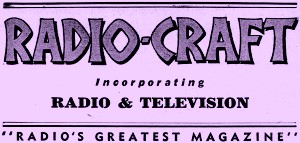|
Nov. / Dec. 1941 Radio-Craft
 [Table
of Contents] [Table
of Contents]
Wax nostalgic about and learn from the history of early electronics.
See articles from Radio-Craft,
published 1929 - 1953. All copyrights are hereby acknowledged.
|
The announcement of the merging
of Radio-Craft and Radio & Television magazines into a
single publication was made on the eve of America's entrance into World War II.
Knowing the visionary talents of publisher Hugo Gernsback, he probably did so
at least partly due to what could be predicted as a severe contraction of the
domestic electronics appliance market once the war machine gears began cranking.
It turns out that he was in fact prescient, because history shows that the government
did direct all critical production to military equipment. Buying a new model
radio, television, washing machine, and to some extent car grew increasingly
difficult from about 1942 through 1945. Even radio amateurs were prohibited
from transmitting during the period for fear of anti-war broadcasts (defined
as both propaganda and sending encoded messages). The relevance of my comments
is that the commercial electronics industry did not require as much coverage
(i.e., many magazines) other than instructing
on repair and research.
Announcing ... Radio-Craft Incorporating Radio & Television
 "Radio's Greatest Magazine" "Radio's Greatest Magazine"
By the Publisher - Hugo Gernsback
Radio-Craft (established 1929) and Radio & Television (established 1930)
are merged into a single magazine beginning with this issue.
So that our readers may understand why this important step was undertaken,
let us state here what prompted this far-reaching decision.
It is no longer news that the entire world is in a turmoil at present and
that the United States is marching forward with giant strides in its re-armament
program.
It has become apparent for some time past that non-essential industries,
in order to conserve resources, must of necessity cooperate with the National
Defense Program. Inasmuch as the two magazines, Radio-Craft and Radio &
Television, were published by the same management, it was felt that for the
duration of the present emergency, it would be best to publish one magazine
instead of two.
From an economic standpoint, there was also to be considered a constantly
shrinking market while the emergency lasted. Many radio manufacturers who formerly
patronized both magazines as well as other radio magazines, were forced to withdraw
their advertising or curtail it severely, on account of priorities.
Many concerns were thus affected, and others will be severely affected as
time goes on. For these reasons it became economically unsound to continue publishing
two magazines at a loss, whereas it is possible to publish one magazine without
a severe loss to its publishers.
While a few large radio manufacturers, - who have defense orders on hand,
- continue to advertise, many of the smaller firms have not been able to do
so; and being unable to obtain substitutes for the materials they need in their
business, had to go into other endeavors, or cease operation altogether.
There was also a further reason which prompted our move, namely a realistic
viewpoint of Television as it is today. Radio & Television magazine for
many years pioneered in television, but when it became increasingly clear that
as long as the present emergency lasts, television would remain at a virtual
stand-still, there was, of course, no further necessity to devote a large part
of an expensive magazine to the subject.
While it is true that the Federal Communications Commission "has given the
green light" to the television industry, making it possible for television broadcasting
to accept commercial advertising now, it is also unfortunately true that all
manufacturers have practically ceased building television equipment for the
duration, due to lack of materials. Under such circumstances, it is clear that
a magazine largely devoted to television becomes pointless at the present time.
On the other hand, Radio & Television devoted the balance of its space
to Amateur Radio. While American amateur radio has not been drastically affected
up to now, the amateur radio industry is also face to face with a difficult
materials problem on account of Defense priorities. And while radio amateurism
has practically stopped completely in most of the countries of the world, it
is still bravely carrying on in the United States, in spite of serious handicaps;
and as long as this country is not officially at war, the radio amateur will
not be suppressed. Most of the section devoted to radio amateurism that appeared
in Radio & Television regularly, will continue intact in Radio-Craft, beginning
with this issue.
It should be understood by our readers that the consolidation of the two
magazines is not to be considered as a final step. When the World War is at
an end, when business returns once more to a peacetime basis, when television
is freed from its war-time shackles, and when radio amateurs all over the world
are free once more to communicate with each other, Radio & Television will
be published as a separate magazine again.
In the meanwhile, Radio-Craft will continue its regular policy of publishing
the same type of articles which it always published, plus a Radio Amateur and
Ham section. And whatever advances are made in television will also be recorded
in Radio-Craft, as before.
For the remainder of the present emergency, we promise to keep Radio-Craft
the same important magazine it always was and, indeed, we hope to better it
from month to month.
The publishers would be happy to receive your letters commenting upon the
present merger of the two magazines.
Posted January 14, 2021
(updated from original post on 10/27/2014)
|









 "Radio's Greatest Magazine"
"Radio's Greatest Magazine" 